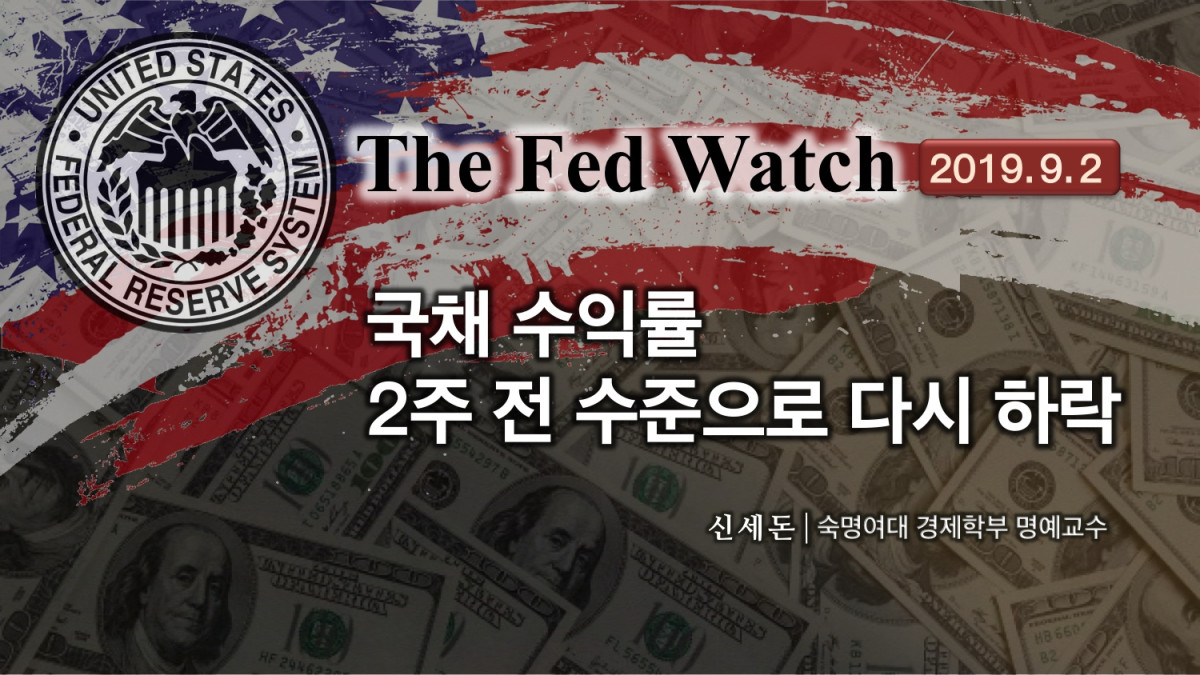국가미래연구원은 폭 넓은 주제를 깊은 통찰력으로 다룹니다
※ 여기에 실린 글은 필자 개인의 의견이며 국가미래연구원(IFS)의 공식입장과는 차이가 있을 수 있습니다.
[FED Watch] 국채 수익률 2주 전 수준으로 다시 하락 - 2019.9.2 본문듣기
작성시간
- 기사입력 2019년09월01일 17시00분
- 최종수정 2019년08월31일 16시01분
관련링크
본문
<1> 금주의 T-Bill Yield Curve : 장기물 중심으로 국채수익률 하락
■ 국채 수익률 전반적으로 2주전 수준으로 반락
- 1월물(불변)을 제외하면 전반적으로 하락
- 만기 20년 및 30년 물 수익률은 10bp 이상 하락
- 향후 경기침체에 관한 불안감이 다시 고조됨에 따라
FOMC의 9월 기준금리 인하 기대감이 고조됨
■ 국채 10년 만기 물 수익률은 지난 주 소폭 하락하였으나
2년 물은 소폭 상승함에 따라 주중 내내 금리역전 현상 지속됨.
- 그러나 시장에서는 금리역전에 대한 경기침체 우려가 상당히 둔화되는 분위기.
<2> FOMC 정책수단 시리즈#3 : 지불준비금(Reserve Requirments) 예치
Reserve requirements are the amount of funds that a depository institution must hold in reserve against specified deposit liabilities. Within limits specified by law, the Board of Governors has sole authority over changes in reserve requirements. Depository institutions must hold reserves in the form of vault cash or deposits with Federal Reserve Banks.
The dollar amount of a depository institution's reserve requirement is determined by applying the reserve ratios specified in the Federal Reserve Board's Regulation D to an institution's reservable liabilities (see table of reserve requirements).
Reservable liabilities consist of net transaction accounts, nonpersonal time deposits, and Eurocurrency liabilities. Since December 27,1990, nonpersonal time deposits and Eurocurrency liabilities have had a reserve ratio of zero.
The reserve ratio on net transactions accounts depends on the amount of net transactions accounts at the depository institution. The Garn-St Germain Act of 1982 exempted the first $2 million of reservable liabilities from eserve requirements. This "exemption amount" is adjusted each year according to a formula specified by the act. The amount of net transaction accounts subject to a reserve requirement ratio of 3 percent was set under the Monetary Control Act of 1980 at $25 million. This "low reserve tranche" is also adjusted each year (see table of low reserve tranche amounts and exemption amounts since 1982).
Net transaction accounts in excess of the low reserve tranche are currently reservable at 10 percent.
<3> 통화정책 의결문(2019년 7월 31일) :
▪ 기준목표금리 0.25%P 인하 : 2.25%-2.50% => 2.0%-2.25%
▪ 지준예치금 금리 0.25%P : 2.35% => 2.10% 인하
▪ 5개 지역 연방은행의 1차 신용금리 인하허용 : 3% => 2.75%
▪ 연준 재할인에서의 2차 및 계절적 신용방식 재도입
■ In a joint meeting of the Federal Open Market Committee (FOMC) and the Board today, the FOMC decided to lower the target range for the federal funds rate by 25 basis points, to 2 to 2-1/4 percent, effective August 1, 2019.
To support the FOMC's decision to lower the target range for the federal funds rate, the Board approved decreasing the interest rate paid on required and excess reserve balances from 2.35 percent to 2.10 percent, effective August 1, 2019.
■ Subject to review and determination by the Board of Governors, the directors of six Reserve Banks had voted to establish a decrease in the rate for discounts and advances under the primary credit program (the primary credit rate). The directors of the Federal Reserve Bank of Philadelphia had voted on July 18, 2019, and the directors of the Federal Reserve Banks of Chicago, St. Louis, Dallas, and San Francisco had voted on July 25, to establish a primary credit rate of 2.75 percent.
The directors of the Federal Reserve Bank of Minneapolis had voted on July 18 to establish a primary credit rate of 2.50 percent. The directors of the Federal Reserve Banks of Boston, New York, Cleveland, and Atlanta had voted on July 25 to establish the primary credit rate at the existing level of 3 percent. (NOTE: At its meeting on July 22, 2019, the Board had taken no action on requests by the Federal Reserve Banks of Philadelphia, St. Louis, and Minneapolis to decrease the primary credit rate and had approved the establishment of the primary credit rate at 3 percent.)
■ At today's meeting, there was consensus for a 25-basis-point decrease, and the Board approved a decrease in the primary credit rate from 3 percent to 2.75 percent, effective August 1, 2019, for the five Reserve Banks that had voted for such a decrease.
The Board's action today on the primary credit rate also included renewal of the existing formulas for calculating the rates applicable to discounts and advances under the secondary and seasonal credit programs. As specified by the formula for the secondary credit rate, this rate would be set 50 basis points above the primary credit rate. As specified by the formula for the seasonal credit rate, this rate would be reset every two weeks as the average of the daily effective federal funds rate and the rate on three month CDs over the previous 14 days, rounded to the nearest 5 basis points.
■ It was understood that a press release and an accompanying document on monetary policy implementation would be issued to announce the decreases in the interest rate on reserve balances and the primary credit rate. In addition, the Secretary was authorized to inform the Federal Reserve Banks of Boston, New York, Cleveland, Richmond, Atlanta, Minneapolis, and Kansas City, on their establishment of a primary credit rate of 2.75 percent, of the Board's approval and determination, effective on the later of August 1, 2019, or the date the Reserve Bank informed the Secretary of its request. (NOTE: Subsequently, the Secretary informed the Boston, New York, Cleveland, Richmond, Atlanta, Minneapolis, and Kansas City Reserve Banks of the Board's approval of their establishment of a primary credit rate of 2.75 percent, effective August 1, 2019.)
<Voting for these actions : 만장일치>
Chair Powell, Vice Chair Clarida, Vice Chair Quarles, Brainard and Bowman.
[부록.1] 지난 주 T-Bill 수익률 동향
- 기사입력 2019년09월01일 17시00분
- 최종수정 2019년08월31일 16시01분
댓글목록
등록된 댓글이 없습니다.

